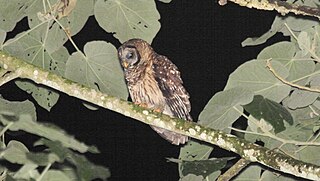
The fulvous owl, or Guatemala barred owl, is a resident of the cloud forests of Central America. A medium-sized true owl, it has a round head, lacking ear tufts. Typical coloration is warm dark brown or reddish brown on the back and lighter brown on the front with darker barring. Adults weigh approximately 600 grams (21 oz), with females being heavier. Its distribution is limited to highland regions of Guatemala, Honduras, and El Salvador. It inhabits elevations from 1,200 to 3,100 meters, and is fairly common within its range. Its behavior is poorly known, as are its population size and distribution. It is classified as a species of least concern by the International Union for Conservation of Nature, although it is considered endangered in Mexico.

Conistra rubiginea, the dotted chestnut, is a moth of the family Noctuidae. The species was first described by Michael Denis and Ignaz Schiffermüller in 1775. It is distributed in Europe and, according to William Warren, Armenia and Asia Minor.

Synemon theresa, the cryptic sun moth, is a moth in the Castniidae family. It is found in Australia, including South Australia and Victoria.

Photedes captiuncula, the least minor, is a moth of the family Noctuidae. It is found throughout Europe, in Turkey, Armenia, Russia and much of temperate Asia.
Striginiana strigina is a moth in the family Eupterotidae. It was described by Westwood in 1849. It is found in Cameroon, the Republic of Congo, Gabon, Sierra Leone, Tanzania and Uganda.
Prolita deoia is a moth of the family Gelechiidae. It was described by Ronald W. Hodges in 1966. It is found in North America, where it has been recorded from California.
Prolita dialis is a moth of the family Gelechiidae. It was described by Ronald W. Hodges in 1966. It is found in North America, where it has been recorded from Arizona, New Mexico, Texas and Mexico.
Prolita geniata is a moth of the family Gelechiidae. It was described by Ronald W. Hodges in 1966. It is found in North America, where it has been recorded from California and Nevada.
Prolita incicur is a moth of the family Gelechiidae. It was described by Ronald W. Hodges in 1966. It is found in North America, where it has been recorded from California, Nevada, Wyoming, Oregon and Colorado.
Prolita jubata is a moth of the family Gelechiidae. It was described by Ronald W. Hodges in 1966. It is found in North America, where it has been recorded from Washington, California, Colorado, Idaho, Montana and Utah.
Prolita maenadis is a moth of the family Gelechiidae. It was described by Ronald W. Hodges in 1966. It is found in North America, where it has been recorded from California.
Prolita nefrens is a moth of the family Gelechiidae. It was described by Ronald W. Hodges in 1966. It is found in North America, where it has been recorded from California, New Mexico, Nevada, Washington, Wyoming and Colorado.
Prolita obnubila is a moth of the family Gelechiidae. It was described by Ronald W. Hodges in 1966. It is found in North America, where it has been recorded from Texas.
Prolita recens is a moth of the family Gelechiidae. It was described by Ronald W. Hodges in 1966. It is found in North America, where it has been recorded from California, Colorado, Montana, New Mexico, Washington and British Columbia.
Prolita sironae is a moth of the family Gelechiidae. It was described by Ronald W. Hodges in 1966. It is found in North America, where it has been recorded from California.
Prolita thaliae is a moth of the family Gelechiidae. It was described by Ronald W. Hodges in 1966. It is found in North America, where it has been recorded from California, Colorado, Utah and Wyoming.
Prolita veledae is a moth of the family Gelechiidae. It was described by Ronald W. Hodges in 1966. It is found in North America, where it has been recorded from California.
Prolita princeps is a moth of the family Gelechiidae. It was described by August Busck in 1910. It is found in North America, where it has been recorded from California, Washington, Montana, Oregon, New Mexico, Utah and British Columbia.
Prolita rectistrigella is a moth of the family Gelechiidae. It was described by William Barnes and August Busck in 1920. It is found in North America, where it has been recorded from California, Arizona, New Mexico, Colorado, Utah, Wyoming, Montana, Washington and Alberta.
Chrysoesthia versicolorella is a moth of the family Gelechiidae. It was described by William D. Kearfott in 1908. It is found in North America, where it has been recorded from California.



